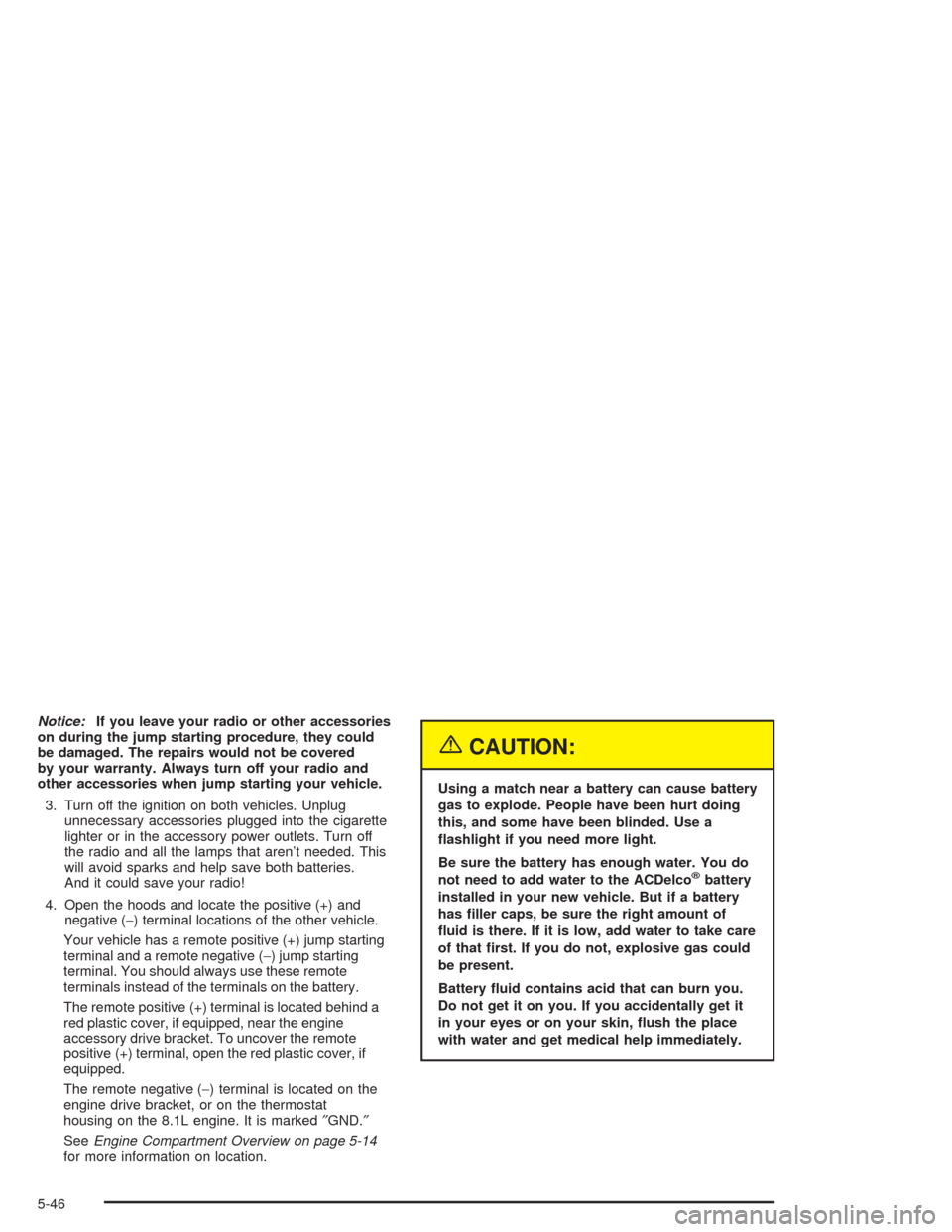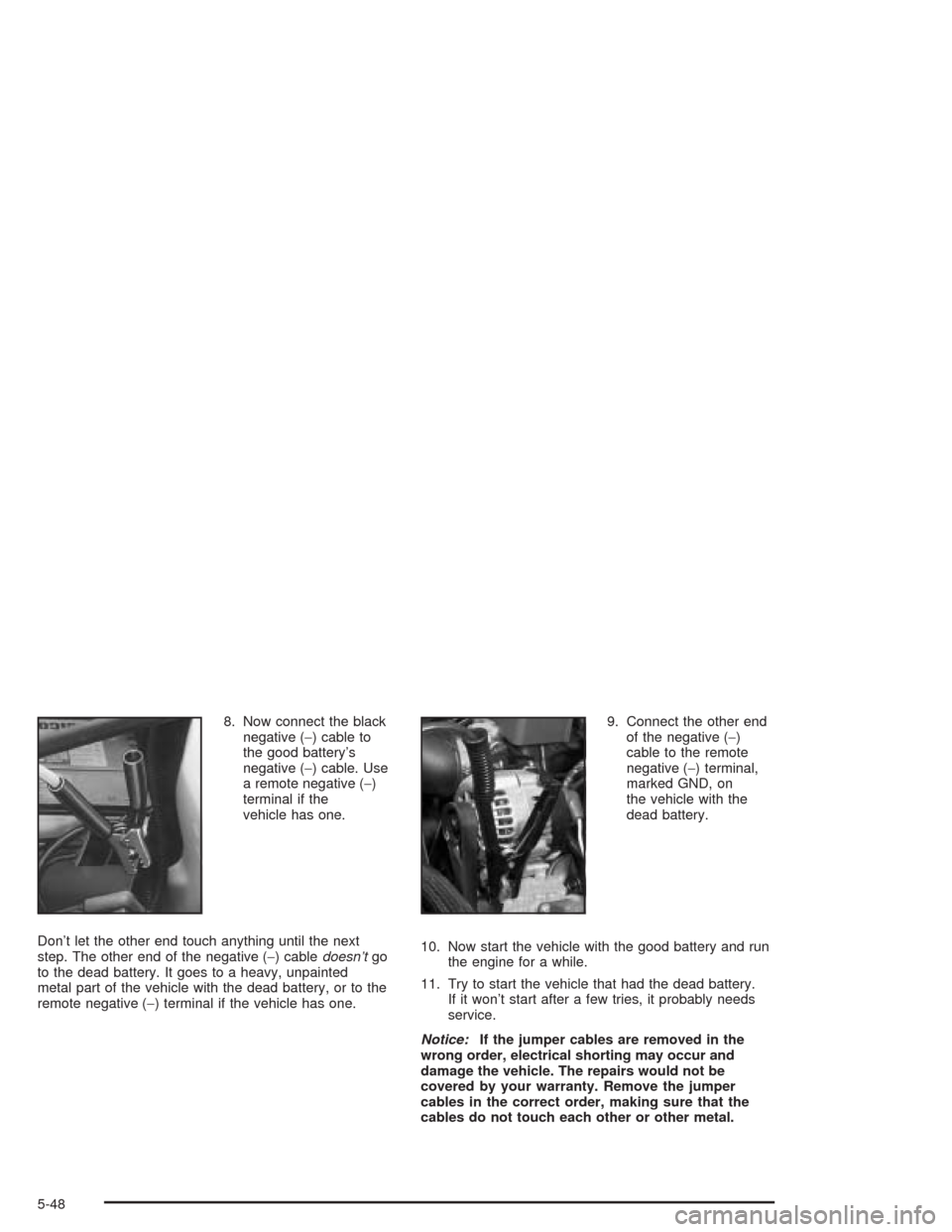Page 401 of 556
A. Engine Air Cleaner/Filter. SeeEngine Air
Cleaner/Filter on page 5-22.
B. Coolant Surge Tank. SeeCooling System on
page 5-32.
C. Air Filter Restriction Indicator (If Equipped). See
Engine Air Cleaner/Filter on page 5-22.
D. Engine Oil Dipstick. SeeEngine Oil on page 5-17.
E. Automatic Transmission Dipstick. SeeAutomatic
Transmission Fluid on page 5-24.
F. Engine Oil Fill. SeeEngine Oil on page 5-17.
G. Fan. SeeCooling System on page 5-32.
H. Remote Negative (−) Terminal (GND). SeeJump
Starting on page 5-44.I. Power Steering Fluid Reservoir. SeePower Steering
Fluid on page 5-38.
J. Remote Positive (+) Terminal. SeeJump Starting on
page 5-44.
K. Brake Master Cylinder Reservoir. SeeBrakes on
page 5-40.
L. Underhood Fuse Block. SeeFuses and Circuit
Breakers on page 5-110.
M. Battery. SeeBattery on page 5-44.
N. Windshield Washer Fluid Reservoir. SeeWindshield
Washer Fluid on page 5-39.
5-15
Page 403 of 556

A. Engine Air Cleaner/Filter. SeeEngine Air
Cleaner/Filter on page 5-22.
B. Coolant Surge Tank. SeeCooling System on
page 5-32.
C. Air Filter Restriction Indicator (If Equipped). See
Engine Air Cleaner/Filter on page 5-22.
D. Engine Oil Dipstick. SeeEngine Oil on page 5-17.
E. Automatic Transmission Dipstick. SeeAutomatic
Transmission Fluid on page 5-24.
F. Engine Oil Fill. SeeEngine Oil on page 5-17.
G. Fan. SeeCooling System on page 5-32.
H. Remote Negative (−) Terminal (GND). SeeJump
Starting on page 5-44.
I. Remote Positive (+) Terminal. SeeJump Starting
on page 5-44.
J. Power Steering Fluid Reservoir. SeePower Steering
Fluid on page 5-38.
K. Brake Master Fluid Reservoir. SeeBrakes on
page 5-40.
L. Underhood Fuse Block. SeeFuses and Circuit
Breakers on page 5-110.
M. Battery. SeeBattery on page 5-44.
N. Windshield Washer Fluid Reservoir. SeeWindshield
Washer Fluid on page 5-39.Engine Oil
If the CHECK OIL LEVEL message appears on the
instrument cluster, it means you need to check
your engine oil level right away.
For more information, see “CHECK OIL LEVEL” under
DIC Warnings and Messages on page 3-68.
You should check your engine oil level regularly; this is
an added reminder.
Checking Engine Oil
It is a good idea to check your engine oil every time you
get fuel. In order to get an accurate reading, the oil
must be warm and the vehicle must be on level ground.
The engine oil dipstick handle is a yellow loop. See
Engine Compartment Overview on page 5-14for
the location of the engine oil dipstick.
Turn off the engine and give the oil several minutes to
drain back into the oil pan. If you don’t, the oil
dipstick might not show the actual level.
Pull out the dipstick and clean it with a paper towel or
cloth, then push it back in all the way. Remove it again,
keeping the tip down, and check the level.
5-17
Page 432 of 556

Notice:If you leave your radio or other accessories
on during the jump starting procedure, they could
be damaged. The repairs would not be covered
by your warranty. Always turn off your radio and
other accessories when jump starting your vehicle.
3. Turn off the ignition on both vehicles. Unplug
unnecessary accessories plugged into the cigarette
lighter or in the accessory power outlets. Turn off
the radio and all the lamps that aren’t needed. This
will avoid sparks and help save both batteries.
And it could save your radio!
4. Open the hoods and locate the positive (+) and
negative (−) terminal locations of the other vehicle.
Your vehicle has a remote positive (+) jump starting
terminal and a remote negative (−) jump starting
terminal. You should always use these remote
terminals instead of the terminals on the battery.
The remote positive (+) terminal is located behind a
red plastic cover, if equipped, near the engine
accessory drive bracket. To uncover the remote
positive (+) terminal, open the red plastic cover, if
equipped.
The remote negative (−) terminal is located on the
engine drive bracket, or on the thermostat
housing on the 8.1L engine. It is marked″GND.″
SeeEngine Compartment Overview on page 5-14
for more information on location.
{CAUTION:
Using a match near a battery can cause battery
gas to explode. People have been hurt doing
this, and some have been blinded. Use a
�ashlight if you need more light.
Be sure the battery has enough water. You do
not need to add water to the ACDelco
®battery
installed in your new vehicle. But if a battery
has �ller caps, be sure the right amount of
�uid is there. If it is low, add water to take care
of that �rst. If you do not, explosive gas could
be present.
Battery �uid contains acid that can burn you.
Do not get it on you. If you accidentally get it
in your eyes or on your skin, �ush the place
with water and get medical help immediately.
5-46
Page 434 of 556

8. Now connect the black
negative (−) cable to
the good battery’s
negative (−) cable. Use
a remote negative (−)
terminal if the
vehicle has one.
Don’t let the other end touch anything until the next
step. The other end of the negative (−) cabledoesn’tgo
to the dead battery. It goes to a heavy, unpainted
metal part of the vehicle with the dead battery, or to the
remote negative (−) terminal if the vehicle has one.9. Connect the other end
of the negative (−)
cable to the remote
negative (−) terminal,
marked GND, on
the vehicle with the
dead battery.
10. Now start the vehicle with the good battery and run
the engine for a while.
11. Try to start the vehicle that had the dead battery.
If it won’t start after a few tries, it probably needs
service.
Notice:If the jumper cables are removed in the
wrong order, electrical shorting may occur and
damage the vehicle. The repairs would not be
covered by your warranty. Remove the jumper
cables in the correct order, making sure that the
cables do not touch each other or other metal.
5-48